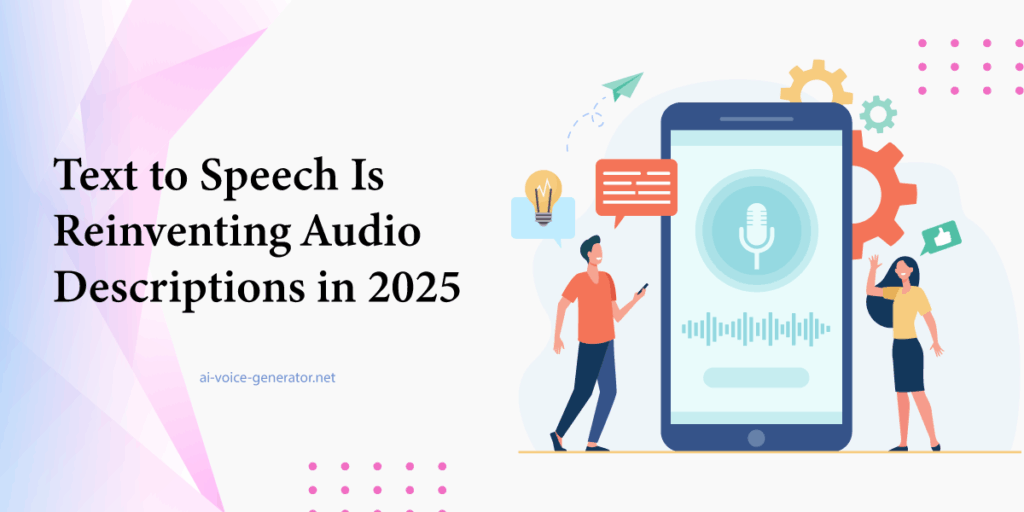
Text to Speech Is Reinventing Audio Descriptions in 2025
The way we access content is undergoing a remarkable shift. As platforms become more inclusive, technology is stepping up to meet diverse needs. Among the most impactful developments in this realm is text to speech, a tool once considered niche, now at the forefront of accessibility innovation. In 2025, this technology is fundamentally transforming how audio descriptions for the visually impaired are created, delivered, and consumed.
With more digital content being published than ever before, there’s a growing need to ensure that all users—including those with visual impairments—can access the same quality of information. This demand has led to an explosion in the use of text to speech free solutions, making access to audio descriptions easier, faster, and significantly more affordable for content creators and organizations alike.
The current surge in interest around assistive technologies coincides with global pushes toward accessibility compliance. Whether it’s educational institutions, media platforms, or government websites, the need for inclusive design has never been more urgent. This is where AI text to speech becomes not just useful, but essential.
The Growing Need for AI-Based Audio Descriptions
Audio descriptions are more than just an accessibility feature—they’re a gateway to information, entertainment, and inclusion. For the visually impaired, having a voice narrate what’s on screen or within an article transforms the experience from passive to engaging. With the increasing volume of content being produced daily, the old method of manually recording these descriptions has become unsustainable.
Enter text to audio free tools, which allow for seamless and instant narration without relying on human voiceover artists. This is especially beneficial for platforms that need to update content frequently or translate information into multiple languages.
As AI-generated audio becomes more refined, we’re seeing a major shift in user preference. Many visually impaired users now lean toward AI-driven audio because it’s consistent, fast, and scalable. Furthermore, as these tools become more intuitive, the line between human and AI voice is nearly indistinguishable.
How Text to Speech Online Is Reshaping Accessibility Standards
Standards for accessibility have evolved significantly over the last few years, with regulators pushing for better compliance across the board. In 2025, this means ensuring that digital assets come with high-quality audio descriptions. Thanks to text to speech online, organizations can now meet these standards more easily without investing in costly voice recording infrastructure.
AI has played a major role in driving this transformation. Not only do these tools allow for real-time generation of descriptions, but they also ensure consistency in tone and delivery, which is crucial for maintaining trust with users. Moreover, with many tools now operating directly from the browser, there’s no need for complex software installations.
This has given rise to the adoption of free online text to speech services, particularly by non-profits, educational institutions, and small businesses. These organizations often lack the budget for professional narration, yet they still need to meet high accessibility standards. Now, they can.
Enhancing Educational Access for the Visually Impaired
Education is one of the primary sectors where the benefits of AI-generated audio descriptions are most evident. Learners who are visually impaired often rely on audio as their primary mode of receiving information. The use of text to voice generator tools allows educators to quickly convert text-based resources into spoken word, making materials accessible without delay.
Moreover, students can now explore a wider range of content, from digital textbooks to online articles, thanks to tools that translate text into natural, easy-to-understand audio. This not only supports learning but also boosts independence and self-reliance among students who would otherwise need constant support.
Today’s text to speech voices are more expressive and adaptive than ever, capable of delivering complex content in ways that are engaging and easy to comprehend. From science to literature, every subject becomes more accessible when paired with smart voice generation technology.
Revolutionizing Public Service and Government Content
One area where AI is making a significant impact is public communication. Government websites, public service announcements, and emergency alerts must be accessible to everyone. With the implementation of text to speech generator technology, agencies can convert all textual updates into audio formats almost instantly.
This advancement ensures that visually impaired users are not excluded from important announcements, legal documents, or policy updates. In emergencies, speed is crucial, and relying on human narrators to record such content is simply not practical. AI solves this problem by offering real-time voice generation that can scale with demand.
As governments embrace digital-first strategies, integrating accessible AI tools becomes not just a convenience but a responsibility. Platforms like AI Voice Generator enable seamless production of such voice content, fulfilling both legal and ethical obligations.
Why the Quality of Text to Speech Voices Matters More Than Ever
Modern users expect more than robotic, monotonous voiceovers. In 2025, quality has become the defining feature of accessibility tools. With text to speech voices now trained on diverse datasets, the audio output is remarkably lifelike and emotionally nuanced.
This is particularly important for audio descriptions, where tone, pace, and inflection play a crucial role in conveying context. A poorly voiced description can lead to confusion or even misinformation. That’s why developers are now investing in voices that are region-specific, accent-aware, and emotionally responsive.
The rise in demand for customized narration has also encouraged platforms to offer more voice options. Whether it’s a calming voice for meditation content or an energetic tone for breaking news, the modern text to voice generator can do it all with precision.
Mainstream Media’s Shift to Text to Speech Integration
Streaming services and digital publishers have also begun leveraging AI text to speech for real-time caption narration and audio description. Unlike traditional closed captions, these narrations can now be offered in multiple languages and updated instantly when the content changes.
For instance, movie and TV platforms are now providing dynamic audio tracks powered by AI, enabling visually impaired users to enjoy media content as fully as anyone else. This not only improves the user experience but also expands the content’s reach to a wider audience.
Many content creators on platforms like YouTube and TikTok are adopting this approach as well. Thanks to text to speech online, these creators can provide inclusive content without investing in expensive editing software or professional voiceovers.
The Future of Personalized Audio Content for Accessibility
One of the most exciting developments in this space is the rise of personalized audio. With AI algorithms learning from user preferences, it’s now possible to tailor narration style, pace, and even vocabulary to fit individual needs. This is the next frontier of accessibility.
Users can select their preferred text to speech voices, adjust speaking speed, and even choose accents that resonate with them. This creates a more intimate and user-focused listening experience, especially useful for long-form content or technical material.
Such flexibility also supports multilingual users. With real-time translation features baked into many free online text to speech tools, accessibility goes beyond disability—it becomes a bridge across language barriers, too.
Tech Startups Driving Accessibility Through Innovation
The boom in accessibility tech has spurred innovation among startups focusing on AI-driven voice solutions. Many of these new companies are targeting underrepresented languages and regional dialects, making it possible for millions of users to access content in their native tongues.
By using text to speech generator APIs, app developers can now embed voice functionalities directly into their platforms. This ensures that users who depend on audio navigation aren’t left behind in the rush toward modernization.
These innovations aren’t limited to websites or educational tools—they’re being integrated into smart home devices, wearables, and even transport systems, ensuring full inclusion for people with visual impairments.
Real-Life Impact: Stories from the Visually Impaired Community
Behind all these technological developments are real people whose lives have been changed. Individuals with visual impairments now report greater independence, improved confidence, and broader access to information.
Thanks to text to speech free platforms, they can read the news, shop online, attend virtual lectures, or navigate new cities—all without assistance. This democratization of access has led to a better quality of life and a stronger sense of agency.
Community feedback also continues to shape how these tools evolve. User input directly influences how AI text to speech systems adapt, becoming more inclusive, emotionally intelligent, and context-aware.
Challenges and Ethical Considerations Moving Forward
Despite the progress, challenges remain. Concerns around voice data privacy, ethical representation in voice cloning, and the risk of over-reliance on automation are all relevant. There’s also the issue of maintaining human touch where it’s most needed.
However, as the industry matures, developers are building better guardrails. Consent protocols, bias audits, and transparent voice databases are becoming standard practice. This ensures that the technology remains trustworthy and effective for all users.
Accessibility is not a one-time fix; it’s a continuous commitment. Tools like text to audio free must be evaluated regularly to ensure they serve users accurately and ethically.
Conclusion
We are entering an era where AI not only augments but transforms accessibility. From education to public services and entertainment, text to speech technology is empowering the visually impaired like never before. What was once a support tool has now become an agent of independence, inclusion, and dignity.
As we look ahead, the role of platforms like AI Voice Generator will only grow. They’re not just making content audible—they’re making it universally reachable.
FAQs
It enables audio descriptions, making content accessible to the visually impaired instantly.
Yes, most voices are now near-human and customizable by tone, speed, and accent.
Absolutely. Many platforms offer free versions tailored for educational content.
Online tools require no installation and work directly through the browser.
Yes, most modern generators offer multilingual support with real-time translation.

